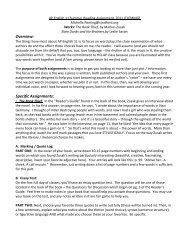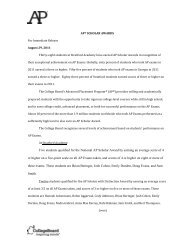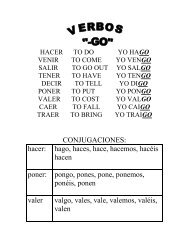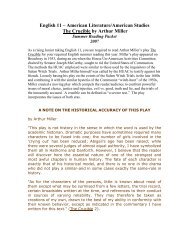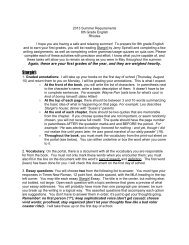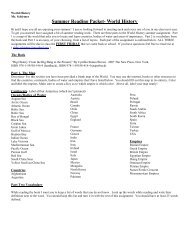1 The Civil War: The Cause
1 The Civil War: The Cause
1 The Civil War: The Cause
Create successful ePaper yourself
Turn your PDF publications into a flip-book with our unique Google optimized e-Paper software.
1<br />
<strong>The</strong> <strong>Civil</strong> <strong>War</strong>: <strong>The</strong> <strong>Cause</strong><br />
Introduction<br />
Beginning with a searing indictment of slavery, Ken Burns’s first episode dramatically evokes the causes of<br />
the war, from the Cotton Kingdom of the South to the northern abolitionists who opposed it. Here are the<br />
burning questions of Union and States’ rights, John Brown at Harper’s Ferry, the election of Abraham<br />
Lincoln in 1860, the firing on Fort Sumter and the jubilant rush to arms on both sides. Along the way the<br />
series’ major figures are introduced: Abraham Lincoln, Frederick Douglass, Robert E. Lee, Ulysses S.<br />
Grant and a host of lesser-known but equally vivid characters. <strong>The</strong> episode comes to a climax with the<br />
disastrous Union defeat at Manassas, Virginia, where both sides now learn it is to be a very long war.<br />
Detailed Episode Description with time code:<br />
Prologue :00 -:01:29<br />
Anecdote about Wilmer McLean who “could rightfully say, 'the war began in my front yard and ended in<br />
my front parlor.'”<br />
1.1 Chapter 1 - THE CIVIL WAR Series Title :01:30 - 10:20<br />
Introduction to the war and to the important characters in the series.<br />
1.2 Chapter 2 - <strong>The</strong> <strong>Cause</strong> :10:21 - :12:28<br />
America in 1861-most of the nation's 31 million people live peaceably on farms and in small towns.
2<br />
1.3 Chapter 3 - All Night Forever :12:29 - :19:12<br />
<strong>The</strong> brutal reality of slavery and its importance to the Southern cotton economy; the invention of the cotton<br />
gin.<br />
1.4 Chapter 4 - Are We Free :19:13 - :23:35<br />
<strong>The</strong> abolitionist movement: William Lloyd Garrison starts publishing <strong>The</strong> Liberator in 1831. Rise of<br />
Harriet Tubman, Wendell Phillips, and Frederick Douglass. Growing rift between North and South over<br />
slavery. Death of Elija P. Lovejoy, white abolitionist. Introduction to John Brown.<br />
1.5 Chapter 5 - A House Divided :23:36 - :27:45<br />
Events leading up to secession: Uncle Tom's Cabin published in 1850; Supreme Court's Dred Scott<br />
Decision; political conflict over entry of new states in the Union. In 1858 Lincoln writes, "a house divided<br />
against itself cannot stand."
3<br />
1.6 Chapter 6 - <strong>The</strong> Meteor :27:46 - :32:43<br />
John Brown raids the arsenal at Harper's Ferry in 1859, and is captured by Colonel Robert E. Lee. <strong>The</strong><br />
Southern militia now becomes a viable instrument; it is the beginning of the Confederate army.<br />
1.7 Chapter 7 - Secessionitis :32:44 - :47:10<br />
In 1860 Abraham Lincoln is elected President. <strong>The</strong> South is horrified. Introduction to George Templeton<br />
Strong, New York lawyer, and diarist. Seven Southern states secede in the time between Lincoln's election<br />
and inauguration. <strong>The</strong> Confederacy inaugurates Mississippi senator Jefferson Davis as President.<br />
Introduction to Mary Chesnut, wife of a prominent Southern planter and diarist.<br />
1.8 Chapter 8 - 4:30 a.m. April 12, 1861 :47:11 - :52:09<br />
Southern artillery attack a battalion of Northern troops inside Fort Sumter, off the coast of South Carolina<br />
in the first battle of the <strong>Civil</strong> <strong>War</strong>. When Union forces surrender, the South is jubilant. Walt Whitman<br />
writes, "all the past we leave behind with Sumter."
4<br />
1.9 Chapter 9 - Traitors and Patriots :52:10 - 1:04:16<br />
Lincoln calls for 75,000 volunteers -- Davis asks for 100,000. Introductions to: Northern soldier (and<br />
diarist) Elisha Hunt Rhodes, Southern soldier (and diarist) Sam Watkins. U.S. Grant, William Tecumseh<br />
Sherman, Nathan Bedford Forrest and Robert E. Lee.<br />
1.10 Chapter 10 - Gun Men 1:04:17 - 1:12:17<br />
<strong>The</strong> first Union troops arrive in Washington. Wherever the Union army goes in the South, slavery<br />
crumbles. Slaves fleeing their plantations for the Union lines are considered "contraband" of war and are<br />
not returned to their former owners.<br />
1.11 Chapter 11 - Manassas 1:12:18 - 1:24:07<br />
When the Union army marches into Virginia, Confederate troops engage them at the Battle of Bull<br />
Run/Manassas. <strong>The</strong> battle, thanks in part to "Stonewall" Jackson, is a Southern victory with an<br />
unprecedented 5,000 casualties. Union troops limp back to Washington.
5<br />
1.12 Chapter 12 - A Thousand Mile Front 1:24:08 - 1:31:17<br />
General George McClellan takes command of the Union army with an elaborate plan to destroy the<br />
Confederacy, but does nothing. U.S. Grant is assigned to desk duty; William T. Sherman resigns, close to<br />
suicide.<br />
1.13 Chapter 13 - Honorable Manhood 1:31:18 - 1:34:50<br />
Sullivan Ballou, a Northern soldier, writes a letter home to his wife before the Battle of Bull Run.
6<br />
<strong>The</strong> <strong>Cause</strong>: Timeline<br />
1787: <strong>The</strong> United States Constitution is ratified; slaves are counted as three-fifths of a<br />
person and enjoy no rights of citizenship.<br />
1793 Eli Whitney, a northerner, invents the cotton gin.<br />
1803 Louisiana Purchase roughly doubles the size of the United States.<br />
1831 William Lloyd Garrison begins publication of radical abolitionist newspaper, <strong>The</strong><br />
Liberator.<br />
1831 55 whites killed in Virginia slave revolt led by Nat Turner.<br />
1837 Pro-slavery mod kills abolitionist editor Elijah P. Lovejoy in Alton, Illinois.<br />
1846- <strong>War</strong> with Mexico adds territory to the United States.<br />
1848<br />
1852 Harriet Beecher Stowe’s inter-national best-seller, Uncle Tom’s Cabin, exposes the<br />
evils of slavery.<br />
1854-5 Anti-slavery northerners found the Republican Party.<br />
1854 <strong>The</strong> Kansas-Nebraska Act allows incoming settlers to decide for themselves whether<br />
to permit slavery.<br />
1857 <strong>The</strong> Supreme Court decides that a slave, Dred Scott, has no rights a white man is<br />
bound to respect.<br />
1858 Abraham Lincoln and Stephen Douglas debate issues in the campaign for Illinois<br />
United States Senate seat.<br />
1859 John Brown is executed for treason against the state of Virginia after his unsuccessful<br />
attempt to incite a slave uprising at Harpers Ferry.<br />
1860 Abraham Lincoln is elected President of the United States.<br />
1861 February - <strong>The</strong> Confederate States of America is formed, with Jefferson Davis sworn<br />
in as president.<br />
1861 March 4 - Abraham Lincoln inaugurated as President of the United States.<br />
1861 April 12 – Confederates fires on Fort Sumter in Charleston Harbor, South Carolina.<br />
1861 April 14 – Lincoln calls for 75,000 volunteers to put down the insurrection.<br />
1861 April 18 – Virginia’s Robert E. Lee rejects Lincoln’s request to command the Union<br />
army.<br />
1861 April 19 – Lincoln orders the blockade of ports in Confederate states.<br />
1861 July 21 – Battle of First Manassas (Bull Run) in Virginia; 4,878 casualties.<br />
<strong>The</strong> information on this handout is taken from the official PBS website for Ken Burns’s film, <strong>The</strong> <strong>Civil</strong> <strong>War</strong><br />
http://www.pbs.org/civilwar






